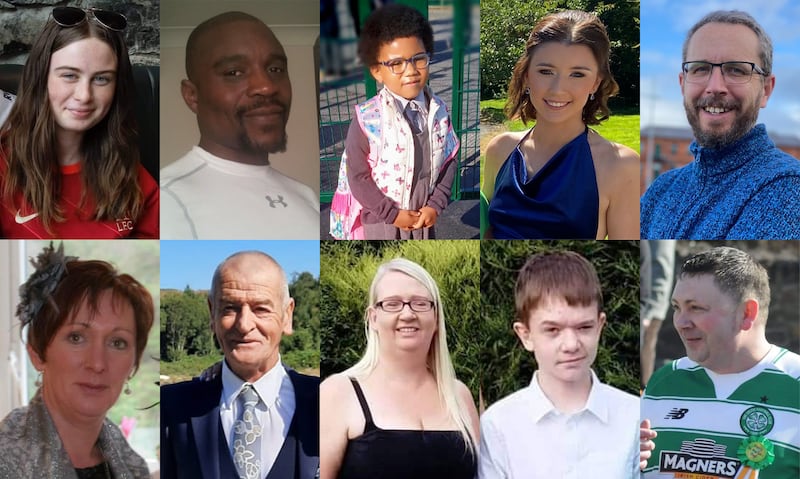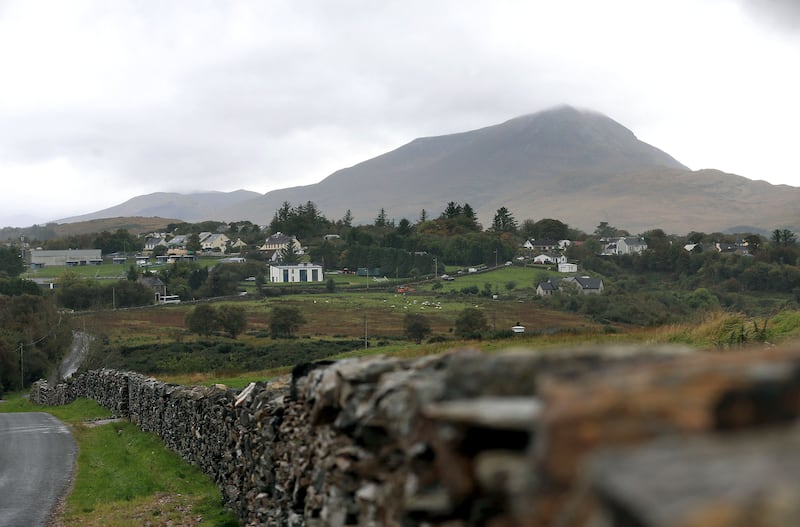In Creeslough – on the street, at the pub, in the shop – there is little talk about what happened on October 7th, 2022.
But there are signs. In the small north Co Donegal village, set amidst the glare of Muckish mountain and sweeping vistas of Sheephaven Bay and the North Atlantic beyond it, marks of tragedy are evident.
In Brennan’s Pharmacy in the village, a leaflet at the checkout counter offers advice: “Anniversary of a loved one – some guidance for coping.”
In the reception area of Creeslough Health Centre, an A4 sheet tacked to a door carries details of a drop-in counselling service for “residents who have been impacted by the Creeslough tragedy”.
RM Block
The only shop in the village is housed in a prefabricated cabin.
And then there is the site itself.
One year ago to the day, 10 people were killed when an explosion ripped through a building housing apartments and a supermarket and adjoining service station.
Leona Harper (14), Robert Garwe (50), Shauna Flanagan Garwe (five), Jessica Gallagher (24), James O’Flaherty (48), Martina Martin (49), Hugh Kelly (59), Catherine O’Donnell (39), James Monaghan (13) and Martin McGill (49) were killed in the tragedy.

Remnants
The remnants of the devastated building remain. The interior of flats – door frames, flaking paint, exposed brickwork – are partially visible from the road.
In the days leading up to the first anniversary, labourers worked to install a new, taller perimeter of timber sheeting at the site, shielding much of the building from view.
[ Gas delivery system now at centre of Garda inquiry into Creeslough explosionOpens in new window ]
Donegal County Council has no plans to demolish the building, a spokesperson said on Thursday, as it is “in private ownership”.
Today, the community will commemorate those lost in the tragedy at a memorial service held at the site of the explosion.
“For people that have lost family members, I can imagine that it’d be very difficult, coming past and seeing the building still there,” says Paul Gamble, sitting in his car in the village late last month.
“The building being there is always a reminder. Even now, to drive past now and see that hoarding... it really brings it back to you.”
‘A sad place’
Away from the site of the explosion, life in Creeslough moves gingerly.
“The town is still a quiet, sad place, you know.” Dr Paul Stewart is sitting at his desk in a consultation room in Creeslough Health Centre. It is late September, and the local GP, dressed in a colourful pullover, is preparing for his first appointment of the day.
Over the past 12 months, Dr Stewart has seen the impacts of the tragedy manifest slowly within the community. Social workers hold clinics at the back of the village’s pharmacy weekly, and an in-house counselling service is operated from the health centre.
[ Priest recalls ‘surreal’ moments in wake of Creeslough disasterOpens in new window ]
“There are people coming to us even now, a year later,” he says. “It has taken a year for them to realise that they have been affected by the [tragedy].”
Outside the clinics, a “quiet sadness” floats. “People don’t talk about it,” he says. “Out in the street, meeting people, they don’t talk about it.”
In the village, many who are approached for comment are hesitant to speak about what happened.
People are now anxious to know what happened, and what the result of the investigation is. Questions are being asked
— Dr Paul Stewart
Close to McNulty’s pub, a woman politely declines to speak to The Irish Times “out of respect” for the bereaved families. “People are very quiet in Creeslough,” she says.
In a pub in the village, another man says he cannot comment because he did not lose anyone in the tragedy.

Frustration
In February, the airing of a TG4 documentary – focused on the efforts of first responders on the day of the tragedy – was met with anger from some bereaved family members. Locals suggest that the negative response to the documentary has made people wary of speaking about the tragedy, for fear of causing undue hurt to those directly impacted.
Nonetheless, within the wider community there are undercurrents of frustration surrounding the inquiry into the explosion.
“People are now anxious to know what happened, and what the result of the investigation is,” Dr Stewart says. “Questions are being asked.”
The Garda investigation continues.
This week, the Garda said that more than 900 statements have been taken during the investigation, and more than 1,350 lines of inquiry followed.
Gardaí are being assisted in the investigation by the Health and Safety Authority (HSA), the Commission for Regulation of Utilities and DNV, a Norwegian-based company “specialising in the investigation and testing of energy systems”. One of DNV’s highest-profile jobs came when it was appointed by the US authorities to investigate what caused the 2010 Deepwater Horizon oil spill in the Gulf of Mexico.
“An Garda Síochána continues to work diligently and as expeditiously as possible, in the circumstances, to ensure that all the circumstances of this fatal explosion are professionally investigated,” a spokesperson said on Thursday.
“We’d like to know [what happened],” says Stanley Hay (77), stopping on the footpath after calling to the post office. “Obviously a year’s gone by, and we have not even an interim report.”
‘Closure’
Another man, who asks not to be identified, becomes animated when asked about the investigation.
“There has to be answers. What happened? We’re looking for answers. People want to know what happened... Closure,” he says, pausing momentarily to greet passersby on the street.
Majella McFadden, a local activist and a manager at Community Links, sits in Creeslough’s new, partially constructed resource centre as she reflects on the tragedy.
It was the randomness of it, I found, which got to me, really. We had all been in the shop; it’s the only shop in town ... It could have been any of us. We just lost 10 of our best
— Dr Paul Stewart
“It’s definitely difficult for the [bereaved] families, when they don’t have the answers,” she says, sitting in her sparsely furnished office. “I suppose it’s hard to move on with the grieving process.”
Paul Gamble, from a few miles outside Creeslough, was in the hardware shop directly across the road from the service station when the explosion occurred.
“[It was] like any other Friday,” Mr Gamble says. “Any other given day, I could have actually went into the shop first. It was just one of those things.
“It would prey on a person’s mind at times,” he says. “What if you had done this, what if you had done that. The difference that could have made.”
Dr Stewart, a first responder at the filling station, says: “It was the randomness of it, I found, which got to me, really. We had all been in the shop; it’s the only shop in town ... It could have been any of us. We just lost 10 of our best.”
‘Doesn’t seem real’
The village isn’t the same since, says a local, Rachel, declining to give her surname while out for a walk. “It feels like everyone’s been in a coma or a daze all year.”
The filling station was often a place to stop and chat with other locals, she says.
“It’s just like the heart was ripped out of the village,” she says.
“It doesn’t seem real... it still seems like a bad dream. Like something you would see on the TV, then switch over to another channel. And that’s what we are afraid of people thinking as well... it’s people’s lives.”
This was not the village’s only tragedy.
On the night of January 30th, 1925, at the Owencarrow Viaduct a short distance outside Creeslough, four people were killed when strong gusts derailed the passenger carriages of a steam engine train travelling to Burtonport, at the northwesterly tip of the county. A memorial plaque, commemorating the disaster, was erected two years ago by Creeslough Community Association.
“They still talk about that in the community. That’s nearly 100 years on now,” Dr Stewart says.
Healing is an ongoing process, Ms McFadden says. “We have a great community spirit. We have had a lot of tragedies in the past before this, but this is... this is something that shook us to the core.”
Support
The focus of the community now, she says, is to support families going through that process. Ms McFadden hopes the new resource centre, located in the village, can play a role in offering that support.
Coming to terms with what happened last October may yet take time, according to Dr Stewart.
“The community, I think, it’s just going to take a while,” he says, “but it will always be there, as a memory.”





















